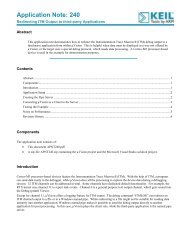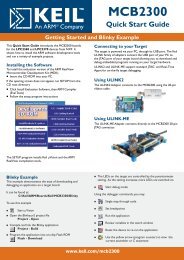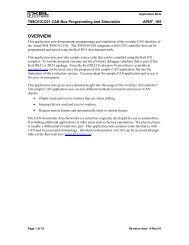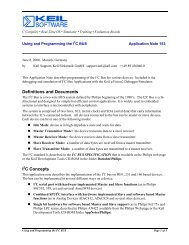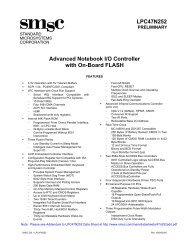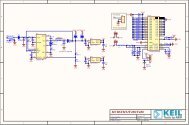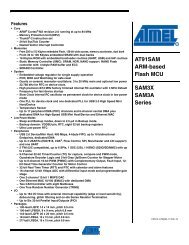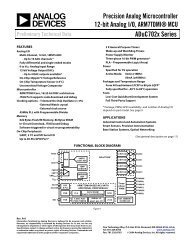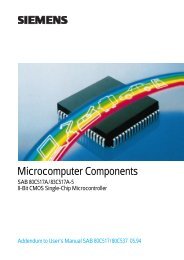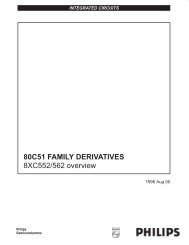You also want an ePaper? Increase the reach of your titles
YUMPU automatically turns print PDFs into web optimized ePapers that Google loves.
84 <strong>AT89C51ID2</strong><br />
W: Write bit (low level at SDA)<br />
A: Acknowledge bit (low level at SDA)<br />
A: Not acknowledge bit (high level at SDA)<br />
<strong>Data</strong>: 8-bit data byte<br />
P : STOP condition<br />
In Figure 33 to Figure 36, circles are used to indicate when the serial interrupt flag is set.<br />
The numbers in the circles show the status code held in SSCS. At these points, a service<br />
routine must be executed to continue or complete the serial transfer. These service<br />
routines are not critical since the serial transfer is suspended until the serial interrupt<br />
flag is cleared by software.<br />
When the serial interrupt routine is entered, the status code in SSCS is used to branch<br />
to the appropriate service routine. For each status code, the required software action<br />
and details of the following serial transfer are given in Table to Table 69.<br />
Master Transmitter Mode In the master transmitter mode, a number of data bytes are transmitted to a slave<br />
receiver (Figure 33). Before the master transmitter mode can be entered, SSCON must<br />
be initialised as follows:<br />
Table 61. SSCON Initialization<br />
CR2 SSIE STA STO SI AA CR1 CR0<br />
bit rate 1 0 0 0 X bit rate bit rate<br />
CR0, CR1 and CR2 define the internal serial bit rate if external bit rate generator is not<br />
used. SSIE must be set to enable TWI. STA, STO and SI must be cleared.<br />
The master transmitter mode may now be entered by setting the STA bit. The 2-wire<br />
logic will now test the 2-wire bus and generate a START condition as soon as the bus<br />
becomes free. When a START condition is transmitted, the serial interrupt flag (SI bit in<br />
SSCON) is set, and the status code in SSCS will be 08h. This status must be used to<br />
vector to an interrupt routine that loads SSDAT with the slave address and the data<br />
direction bit (SLA+W).<br />
When the slave address and the direction bit have been transmitted and an acknowledgement<br />
bit has been received, SI is set again and a number of status code in SSCS<br />
are possible. There are 18h, 20h or 38h for the master mode and also 68h, 78h or B0h if<br />
the slave mode was enabled (AA=logic 1). The appropriate action to be taken for each<br />
of these status code is detailed in Table . This scheme is repeated until a STOP condition<br />
is transmitted.<br />
SSIE, CR2, CR1 and CR0 are not affected by the serial transfer and are referred to<br />
Table 7 to Table 11. After a repeated START condition (state 10h) the TWI module may<br />
switch to the master receiver mode by loading SSDAT with SLA+R.<br />
Master Receiver Mode In the master receiver mode, a number of data bytes are received from a slave transmitter<br />
(Figure 34). The transfer is initialized as in the master transmitter mode. When the<br />
START condition has been transmitted, the interrupt routine must load SSDAT with the<br />
7-bit slave address and the data direction bit (SLA+R). The serial interrupt flag SI must<br />
then be cleared before the serial transfer can continue.<br />
4289A–8051–09/03



